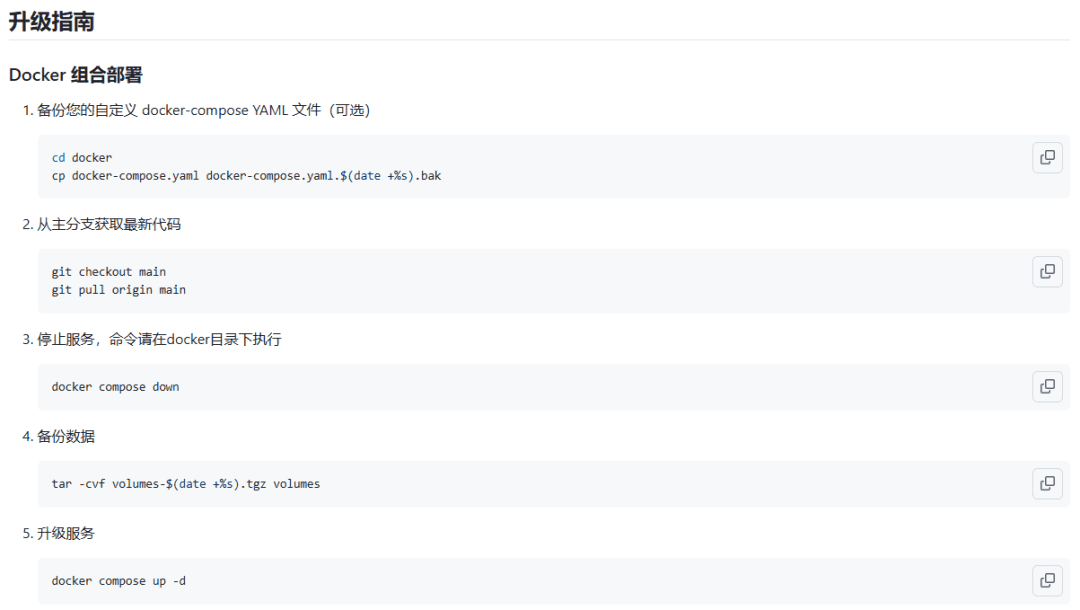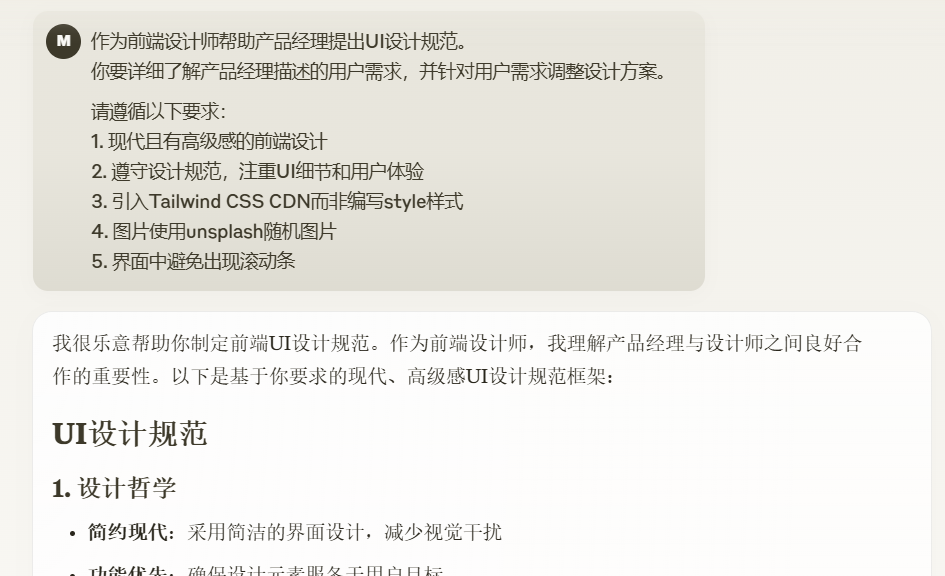DeepSeek 推出一系列先进推理模型,挑战 OpenAI 行业地位,且完全免费、无使用限制,惠及所有用户。
本文将介绍如何使用 Hugging Face 的医学思维链数据集,对 DeepSeek-R1-Distill-Llama-8B 模型进行微调。这款精简版 DeepSeek-R1 模型,通过在 DeepSeek-R1 生成的数据上微调 Llama 3 8B 模型而得,展现出与原模型相近的卓越推理能力。
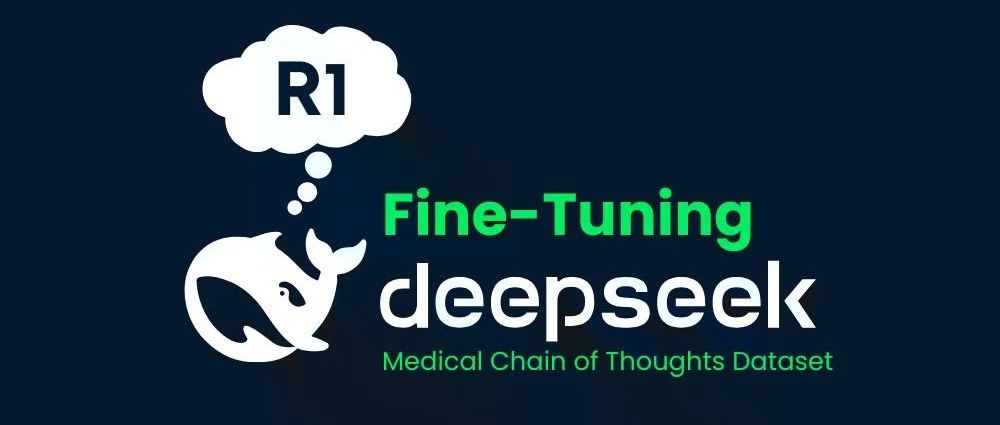
DeepSeek R1 解密
DeepSeek-R1 与 DeepSeek-R1-Zero 在数学、编程及逻辑推理任务中,性能均可比肩 OpenAI 的 o1 模型。值得一提的是,R1 和 R1-Zero 均为开源模型。
DeepSeek-R1-Zero
DeepSeek-R1-Zero 作为首个完全采用大规模强化学习 (RL, Reinforcement Learning) 训练的开源模型,有别于传统以监督微调 (SFT, Supervised Fine-Tuning) 为初始步骤的模型。这种创新方法赋予了模型独立探索思维链 (CoT, Chain-of-Thought) 推理的能力,使其能够解决复杂问题并迭代优化输出结果。然而,此方法也带来了一些挑战,例如推理步骤可能出现重复、可读性降低以及语言风格不统一等问题,进而影响模型的清晰度和实用性。
DeepSeek-R1
DeepSeek-R1 的发布旨在克服 DeepSeek-R1-Zero 的不足。通过在强化学习之前引入冷启动数据,DeepSeek-R1 为推理和非推理任务奠定了更坚实的基础。这种多阶段训练策略使得 DeepSeek-R1 在数学、编程和推理基准测试中,能够达到与 OpenAI-o1 匹敌的领先水平,并显著提升了输出内容的可读性与连贯性。
DeepSeek 蒸馏模型
DeepSeek 还推出了蒸馏模型系列。这些模型在保持卓越推理性能的同时,体积更小、效率更高。虽然参数规模从 1.5B 到 70B 不等,但这些模型均保留了强大的推理能力。其中,DeepSeek-R1-Distill-Qwen-32B 在多项基准测试中,性能超越了 OpenAI-o1-mini 模型。更小规模的模型继承了大型模型的推理模式,充分证明了蒸馏技术的有效性。
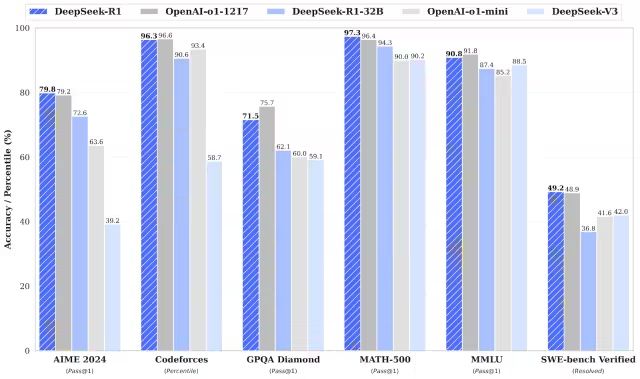
DeepSeek R1 微调实战
1. 环境配置
在本次模型微调实践中,选用 Kaggle 作为云端 IDE,原因在于 Kaggle 提供了免费的 GPU 资源。最初选择了两块 T4 GPU,但最终仅使用了一块。若用户希望在本地计算机上进行模型微调,则至少需要配备一块具备 16GB 显存的 RTX 3090 显卡。
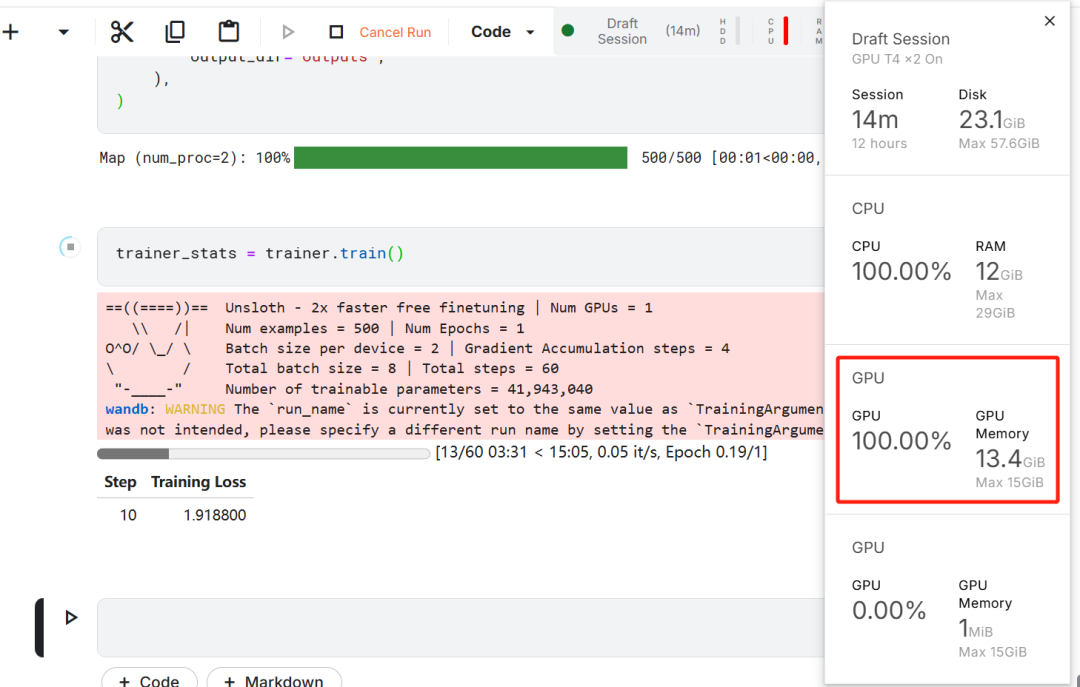
首先,启动一个新的 Kaggle notebook,并将用户的 Hugging Face token 和 Weights & Biases token 添加为密钥。
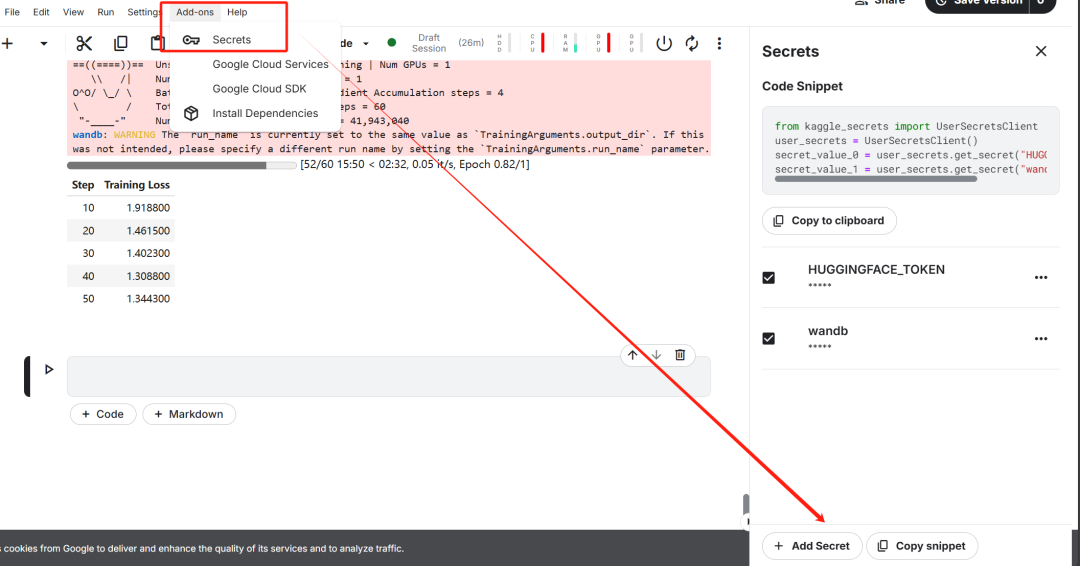
完成密钥设置后,安装 unsloth Python 包。Unsloth 是一款开源框架,旨在将大型语言模型 (LLM) 的微调速度提升一倍,并显著提高内存效率。
%%capture
!pip install unsloth
!pip install --force-reinstall --no-cache-dir --no-deps git+https://github.com/unslothai/unsloth.git
接下来,登录 Hugging Face CLI。此步骤对于后续下载数据集以及上传微调后的模型至关重要。
from huggingface_hub import login
from kaggle_secrets import UserSecretsClient
user_secrets = UserSecretsClient()
hf_token = user_secrets.get_secret("HUGGINGFACE_TOKEN")
login(hf_token)
然后,登录 Weights & Biases (wandb),并创建一个新项目,以便跟踪实验过程和微调进度。
import wandb
wb_token = user_secrets.get_secret("wandb")
wandb.login(key=wb_token)
run = wandb.init(
project='Fine-tune-DeepSeek-R1-Distill-Llama-8B on Medical COT Dataset',
job_type="training",
anonymous="allow"
)
2. 模型与 tokenizer 加载
在本文的实践中,加载了 Unsloth 版本的 DeepSeek-R1-Distill-Llama-8B 模型。
https://huggingface.co/unsloth/DeepSeek-R1-Distill-Llama-8B
为了优化内存使用和提升性能,选择了以 4-bit 量化的方式加载模型。
from unsloth import FastLanguageModel
max_seq_length = 2048
dtype = None
load_in_4bit = True
model, tokenizer = FastLanguageModel.from_pretrained(
model_name="unsloth/DeepSeek-R1-Distill-Llama-8B",
max_seq_length=max_seq_length,
dtype=dtype,
load_in_4bit=load_in_4bit,
token=hf_token,
)
3. 微调前模型推理能力初探
为了构建模型的提示模板,定义了一个系统提示,并在其中加入了问题和答案生成的占位符。此提示旨在引导模型逐步思考,并最终生成逻辑严谨且准确的回答。
prompt_style = """Below is an instruction that describes a task, paired with an input that provides further context.
Write a response that appropriately completes the request.
Before answering, think carefully about the question and create a step-by-step chain of thoughts to ensure a logical and accurate response.
### Instruction:
You are a medical expert with advanced knowledge in clinical reasoning, diagnostics, and treatment planning.
Please answer the following medical question.
### Question:
{}
### Response:
<think>{}"""
在此示例中,向 prompt_style 提供了一个医学问题,并将其转化为 tokens,随后将这些 tokens 传递给模型以生成答案。
question = "A 61-year-old woman with a long history of involuntary urine loss during activities like coughing or sneezing but no leakage at night undergoes a gynecological exam and Q-tip test. Based on these findings, what would cystometry most likely reveal about her residual volume and detrusor contractions?"
FastLanguageModel.for_inference(model)
inputs = tokenizer([prompt_style.format(question, "")], return_tensors="pt").to("cuda")
outputs = model.generate(
input_ids=inputs.input_ids,
attention_mask=inputs.attention_mask,
max_new_tokens=1200,
use_cache=True,
)
response = tokenizer.batch_decode(outputs)
print(response[0].split("### Response:")[1])
上述医学问题的核心内容是:
一位 61 岁女性,长期在咳嗽或打喷嚏等活动中出现非自愿性漏尿,但夜间无漏尿现象。她接受了妇科检查和 Q-tip 测试。基于这些检查结果,膀胱测压最可能揭示其残余尿量和逼尿肌收缩状态的哪些信息?
即使在未经微调的情况下,该模型也成功生成了思维链,并在给出最终答案前进行了严谨的推理,整个推理过程被封装在 <think></think> 标签内。
那么,为何仍需进行微调?尽管模型展现出了详细的推理过程,但其表达略显冗长,不够简洁。此外,最终答案以项目符号列表的形式呈现,这与期望微调的数据集的结构和风格存在偏差。
4. 数据集加载与预处理
对提示模板进行了微调,以适应数据集的处理需求,具体方法是在提示模板中为复杂的思维链 (Complex Chain-of-Thought) 列添加了第三个占位符。
train_prompt_style = """Below is an instruction that describes a task, paired with an input that provides further context.
Write a response that appropriately completes the request.
Before answering, think carefully about the question and create a step-by-step chain of thoughts to ensure a logical and accurate response.
### Instruction:
You are a medical expert with advanced knowledge in clinical reasoning, diagnostics, and treatment planning.
Please answer the following medical question.
### Question:
{}
### Response:
<think>
{}
</think>
{}"""
编写了一个 Python 函数,用于在数据集中创建 “text” 列。该列的内容由训练提示模板构成,并将占位符分别填充为问题、思维链和答案。
EOS_TOKEN = tokenizer.eos_token # Must add EOS_TOKEN
def formatting_prompts_func(examples):
inputs = examples["Question"]
cots = examples["Complex_CoT"]
outputs = examples["Response"]
texts = []
for input, cot, output in zip(inputs, cots, outputs):
text = train_prompt_style.format(input, cot, output) + EOS_TOKEN
texts.append(text)
return {
"text": texts,
}
从 Hugging Face Hub 加载了 FreedomIntelligence/medical-o1-reasoning-SFT 数据集的前 500 个样本。
https://huggingface.co/datasets/FreedomIntelligence/medical-o1-reasoning-SFT?row=46
随后,使用 formatting_prompts_func 函数对数据集的 “text” 列进行了映射处理。
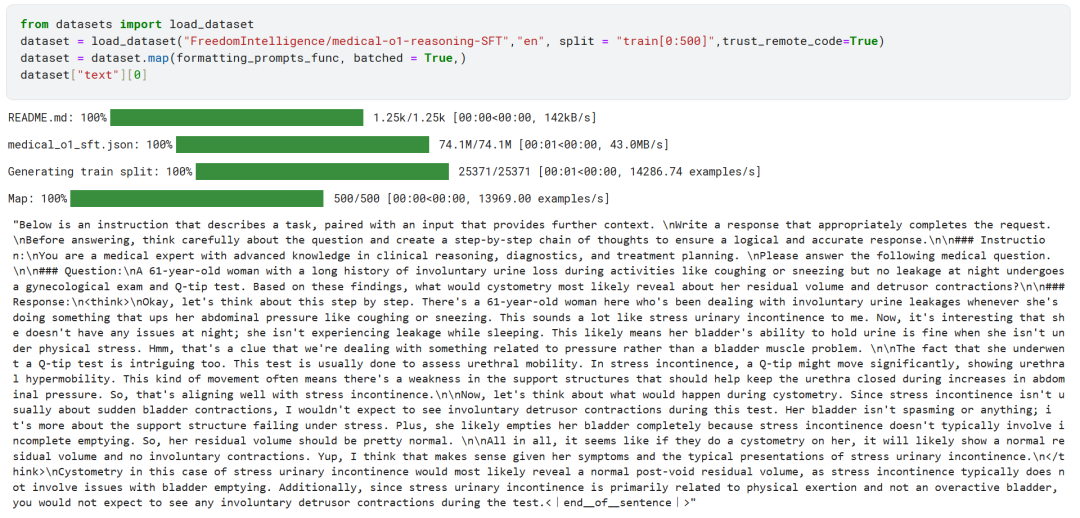
如上图所示,"text" 列已成功整合了系统提示、指令、思维链以及最终答案。
5. 模型配置
通过设定目标模块,采用低秩适配器 (Low-Rank Adapter) 技术对模型进行配置。
model = FastLanguageModel.get_peft_model(
model,
r=16,
target_modules=[
"q_proj",
"k_proj",
"v_proj",
"o_proj",
"gate_proj",
"up_proj",
"down_proj",
],
lora_alpha=16,
lora_dropout=0,
bias="none",
use_gradient_checkpointing="unsloth", # True or "unsloth" for very long context
random_state=3407,
use_rslora=False,
loftq_config=None,
)
接下来,配置了训练参数和训练器 (Trainer)。通过向训练器提供模型、tokenizer、数据集以及其他关键训练参数,以优化模型的微调过程。
from trl import SFTTrainer
from transformers import TrainingArguments
from unsloth import is_bfloat16_supported
trainer = SFTTrainer(
model=model,
tokenizer=tokenizer,
train_dataset=dataset,
dataset_text_field="text",
max_seq_length=max_seq_length,
dataset_num_proc=2,
args=TrainingArguments(
per_device_train_batch_size=2,
gradient_accumulation_steps=4,
# Use num_train_epochs = 1, warmup_ratio for full training runs!
warmup_steps=5,
max_steps=60,
learning_rate=2e-4,
fp16=not is_bfloat16_supported(),
bf16=is_bfloat16_supported(),
logging_steps=10,
optim="adamw_8bit",
weight_decay=0.01,
lr_scheduler_type="linear",
seed=3407,
output_dir="outputs",
),
)
6. 模型训练
trainer_stats = trainer.train()
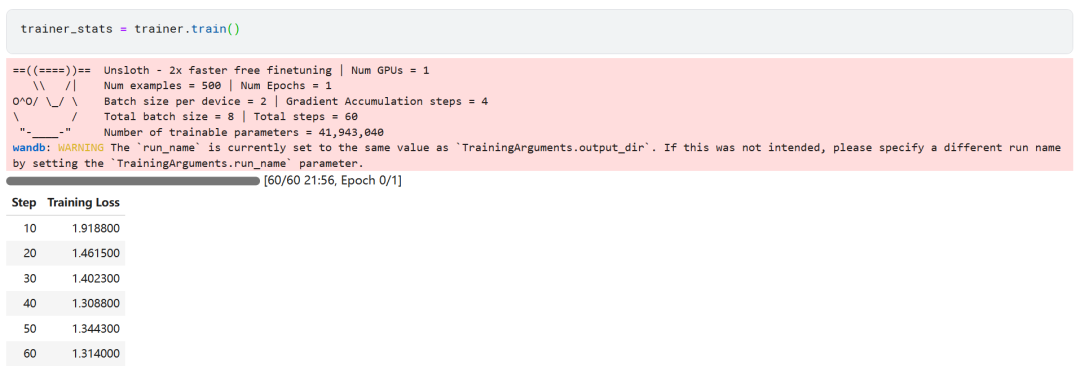
模型训练过程耗时 22 分钟。训练损失 (loss) 逐渐降低,表明模型性能有所提升,这是一个积极的信号。
用户可以登录 Weights & Biases 网站,查看完整的模型评估报告。
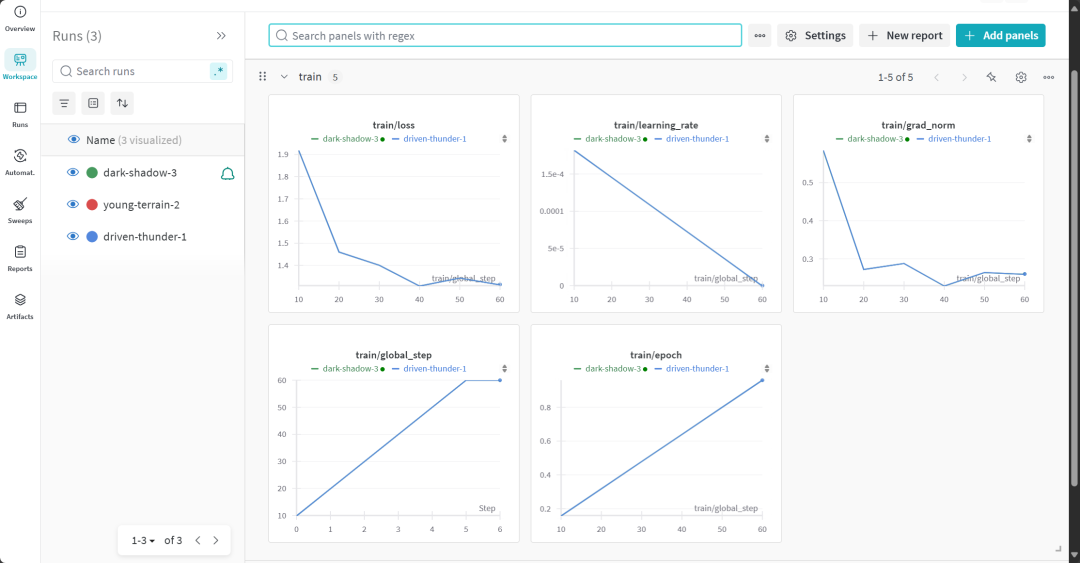
7. 微调后模型推理能力评估
为了进行对比分析,再次向微调后的模型提出了与微调前相同的问题,以观察模型性能的变化。
question = "A 61-year-old woman with a long history of involuntary urine loss during activities like coughing or sneezing but no leakage at night undergoes a gynecological exam and Q-tip test. Based on these findings, what would cystometry most likely reveal about her residual volume and detrusor contractions?"
FastLanguageModel.for_inference(model) # Unsloth has 2x faster inference!
inputs = tokenizer([prompt_style.format(question, "")], return_tensors="pt").to("cuda")
outputs = model.generate(
input_ids=inputs.input_ids,
attention_mask=inputs.attention_mask,
max_new_tokens=1200,
use_cache=True,
)
response = tokenizer.batch_decode(outputs)
print(response[0].split("### Response:")[1])
实验结果表明,微调后模型的输出质量得到了显著提升,答案更加精准。思维链的呈现更为简洁明了,最终答案也更加直接,仅用一段话便清晰作答,表明此次模型微调取得了成功。
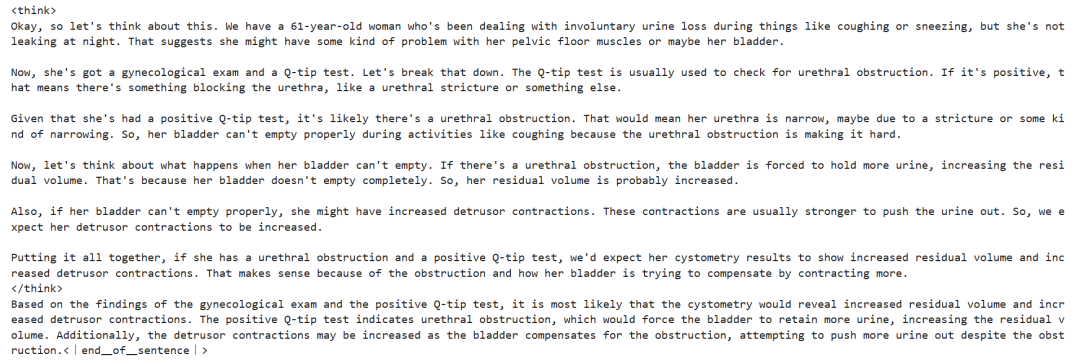
8. 模型本地存储
现在,将适配器 (adapter)、完整模型以及 tokenizer 保存至本地,以便在其他项目中使用。
new_model_local = "DeepSeek-R1-Medical-COT"
model.save_pretrained(new_model_local)
tokenizer.save_pretrained(new_model_local)
model.save_pretrained_merged(new_model_local, tokenizer, save_method="merged_16bit")
9. 模型上传至 Hugging Face Hub
还将适配器、tokenizer 和完整模型推送至 Hugging Face Hub,旨在使 AI 社区能够充分利用这一微调模型,并将其便捷地集成到各自的系统中。
new_model_online = "realyinchen/DeepSeek-R1-Medical-COT"
model.push_to_hub(new_model_online)
tokenizer.push_to_hub(new_model_online)
model.push_to_hub_merged(new_model_online, tokenizer, save_method="merged_16bit")
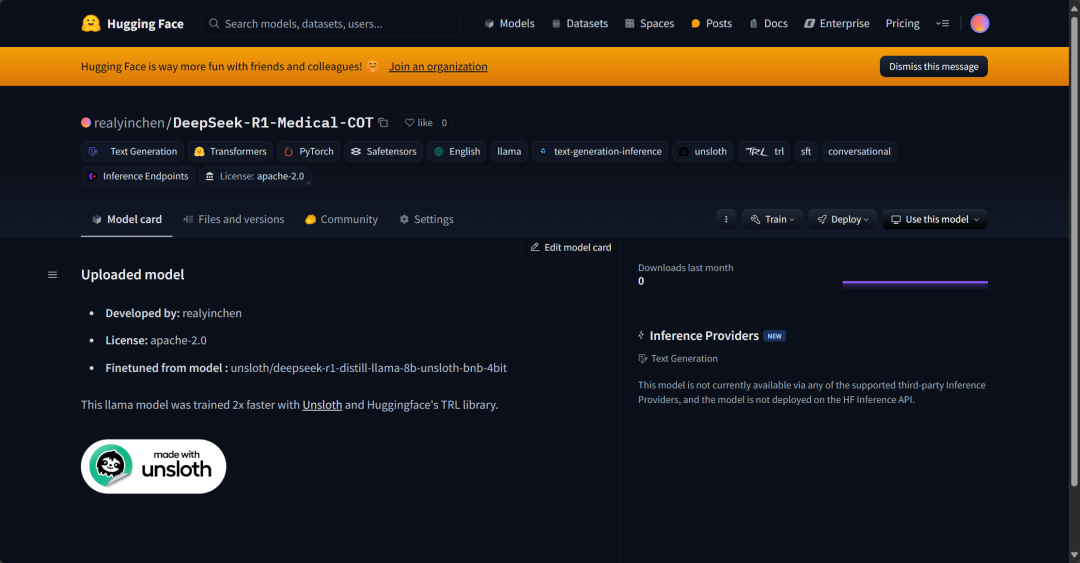
总结
人工智能 (AI) 领域正经历着日新月异的变革。开源社区的崛起,对过去三年由专有模型主导的 AI 格局提出了有力挑战。 开源大型语言模型 (LLM) 的性能日益提升,速度更快,效率更高,使得在较低的计算和内存资源条件下对其进行微调,变得前所未有的便捷。
本文深入探讨了 DeepSeek R1 推理模型,并详细介绍了如何对其精简版本进行微调,以应用于医学问答场景。微调后的推理模型不仅性能显著提升,更使其在医学、急救服务和医疗保健等关键领域具备了实际应用价值。
为积极应对 DeepSeek R1 的发布,OpenAI 亦迅速推出了两项重要工具:更先进的推理模型 o3,以及 Operator AI Agent。后者依托于全新的计算机使用 Agent (CUA, Computer Use Agent) 模型,展现出自主浏览网站并执行复杂任务的能力。
源代码:
https://www.kaggle.com/code/realyinchen/deepseek-r1-medical-cot
© 版权声明
文章版权归 AI分享圈 所有,未经允许请勿转载。
相关文章

暂无评论...

